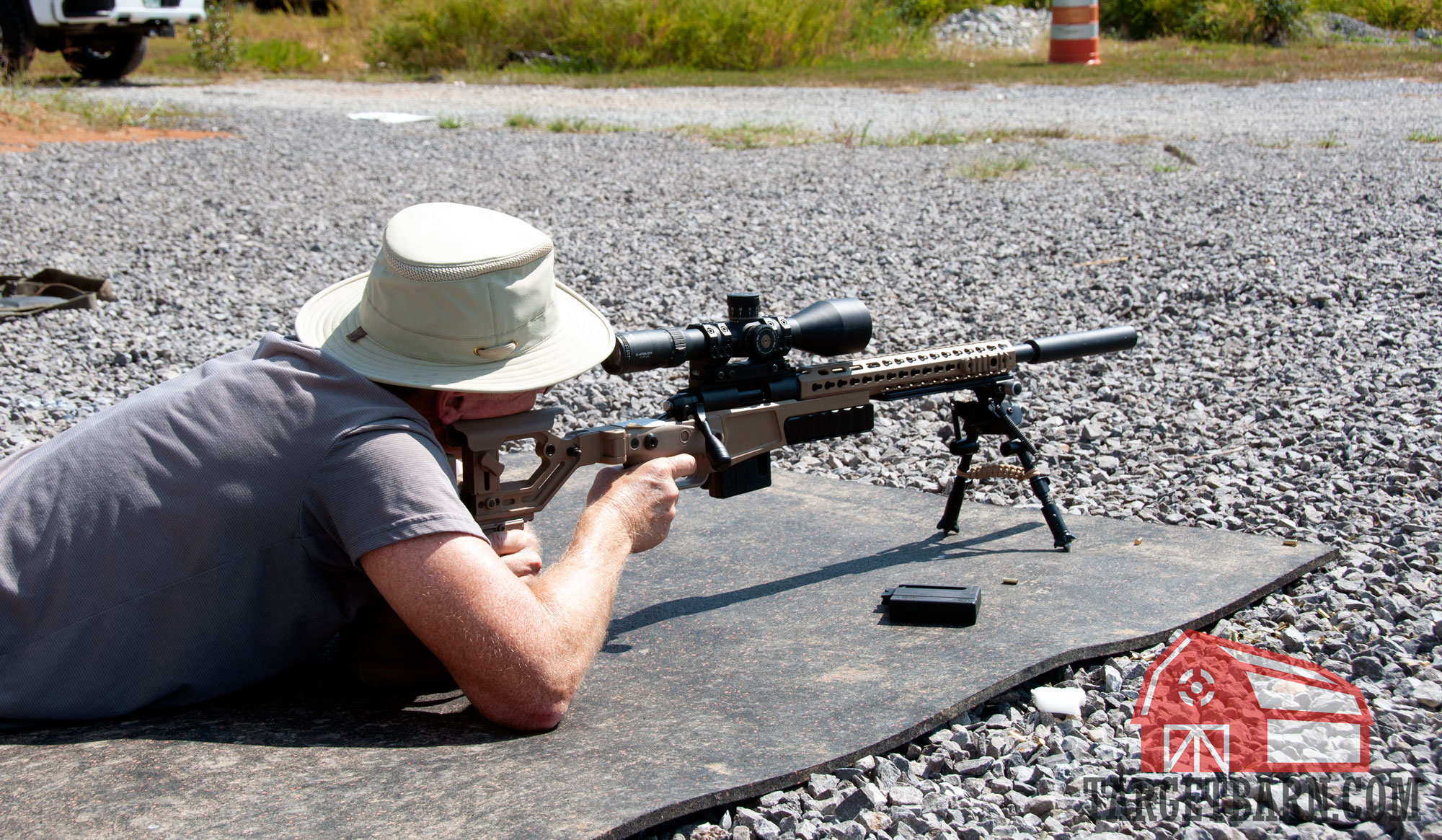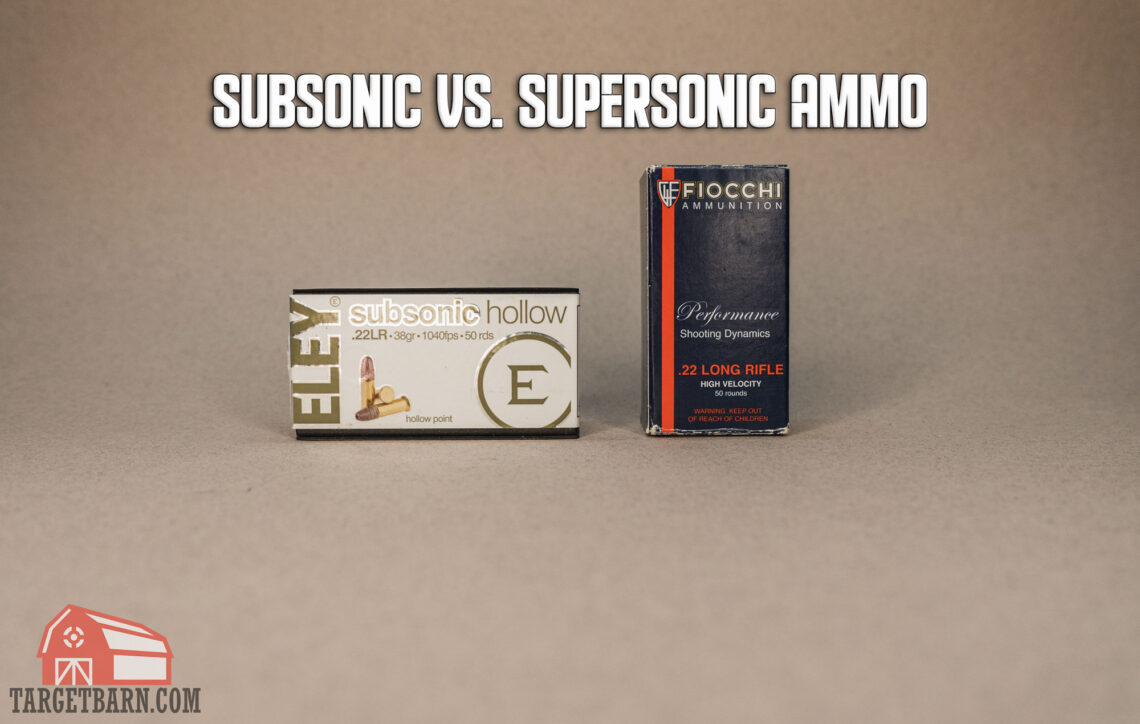If you’ve been a shooter for awhile, you’ve likely heard the terms subsonic vs. supersonic ammo. Unless you’re heavily invested in shooting, you might not know what these terms mean.
So, let’s explore the differences between subsonic vs. supersonic ammo and what you need to know about each.
Subsonic vs. Supersonic Ammo: What’s the Difference?

- The difference between subsonic vs. supersonic ammo is whether the round travels fast enough to break the sound barrier
- Subsonic ammo travels slower than the speed of sound
- Supersonic ammo travels faster than the speed of sound
- Subsonic ammo pairs up best with a suppressor for quiet shooting
- Supersonic ammo is the most commonly used type of round
- Supersonic ammo is louder than subsonic ammo, making a “crack” noise as it breaks the sound barrier
When air temperature is 68 °F, the speed of sound is roughly 1,125 feet per second (fps). If a bullet’s muzzle velocity (the velocity at which it exits the barrel) is lower than 1,125 fps, it is subsonic. When its muzzle velocity is 1,125 fps or higher, it is supersonic.
Sub: under. Super: above. Sonic: sound. Simple stuff, right?
Now, bear in mind, several factors determine whether ammo is subsonic or not. Those factors include atmospheric conditions, barrel length, and variations in ammo manufacturing.
Atmospheric Conditions
Temperature impacts the speed of sound. It also potentially impacts if your ammo is considered subsonic or supersonic. The speed of sound changes with the temperature. When the air is a freezing 32°F, the speed of sound drops to 1,086 fps as a result. If the temperature warms up, the speed of sound increases. So, a round that’s near that 1,100 mark could one day be supersonic and be considered subsonic the next — if the temperature changes.
Barrel Length
Barrel length can also spell the difference between subsonic vs. supersonic performance. A .22 LR cartridge with a subsonic muzzle velocity in a handgun can easily become supersonic when it is fired in a rifle. That’s because a longer barrel gives propellant gas more time to push against and accelerate the bullet.
Variations in Ammo Manufacturing
Finally, a cartridge’s advertised muzzle velocity is seldom the one it will actually deliver. Slight variations during manufacturing cause cartridges from the same lot of ammo to exhibit significantly different muzzle velocities. Increasing barrel temperature resulting from repeated fire will impact muzzle velocity as well. That’s why ammo with an advertised muzzle velocity of 1,125 fps is likely to treat the shooter to both subsonic and supersonic performance.
Now that you’ve got a grasp of subsonic vs. supersonic ammo, let’s look at the pros and cons of each. When do you want subsonic ammo – and when do you want supersonic?
Supersonic Ammo Advantages
By definition, supersonic ammo has a higher muzzle velocity than subsonic. A faster-moving bullet offers two advantages: a flatter trajectory, and greater striking energy.
Gravity is constant. If two bullets fly through the air for a span of one second, gravity will pull both bullets the same distance downward. But what if one of those bullets is traveling at a higher velocity? It would cover a longer distance within the same amount of time, all while exhibiting the same degree of bullet drop. In other words, the faster bullet follows a flatter overall trajectory.
A flatter trajectory doesn’t necessarily improve accuracy, although shooters frequently find it easier to line up shots when they don’t have to take as much bullet drop into consideration.
Striking energy is a product of two variables: velocity, and bullet weight. (It’s the same principle of physics that explains why you’d rather get hit with a bat when it’s swung by a preschooler instead of Mark McGuire when he’s angry.)
If two bullets of the same weight are traveling at different velocities and strike their targets at the same distance, the bullet with the higher velocity will transfer greater kinetic energy to its target. While many other factors determine a bullet’s efficacy for self-defense (e.g. shot placement), a higher-velocity bullet does typically have greater capacity to inflict damage to its target.
Subsonic Ammo Advantages

It sounds like supersonic ammo wins the day, doesn’t it? Not exactly. While a lower-velocity bullet does exhibit more pronounced drop and arrive at its target with less kinetic energy, it also offers the distinct advantage of quieter performance.
You’re probably already aware of the phenomenon known as a sonic boom. When a jet breaks the sound barrier (at which instant its velocity transitions from subsonic to supersonic), it sends out a blast of extremely loud sound waves. Likewise, when a bullet breaks the sound barrier, it issues a sharp cracking report.
Subsonic ammo prevents the distinctive “crack” entirely. That’s why it’s preferred when subtler performance is desired, such as by a shooter who wants to conserve their hearing if they ever have to fire in self-defense while they’re indoors. It’s also why subsonic ammo is recommended for firearms with suppressors: it makes the suppressor’s job easier by giving it less sound to muffle.
There are a couple of downsides to subsonic ammo. First, because it is a heavier bullet traveling at a slower velocity, it does not have the stability to make accurate long-distance shots. In AR-15s and other semi-auto rifles, subsonic rounds have trouble getting enough pressure to make the rifle run reliably.
Not All Ammo Can Be Both Supersonic and Subsonic

Some rounds are available both as supersonic or subsonic. .300 AAC Blackout ammo is popular for its subsonic performance, but plenty of supersonic options are also available. Subsonic .22 LR is popular for match shooting, while varmint hunters prefer supersonic .22 LR. When it has a 147 grain bullet, a 9mm cartridge is subsonic. When its bullet is lighter at 115 grains, it is supersonic.
Not all cartridges can be subsonic. You’ll never find a subsonic .22-250 Rem or .17 Rem, and subsonic 5.56×45 and .308 Win are both somewhat unusual specialty items. On the flip side, many rounds are traditionally subsonic, such as .38 Special, .45 ACP and .45 Long Colt. Though, all of these have supersonic variants with abnormally lightweight bullets.
The best way to understand the differences between supersonic and subsonic ammo? That’s easy: give both a college try. This is conveniently also the only way to be sure of which one you prefer!












